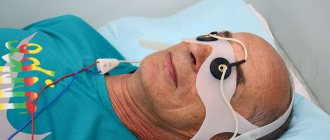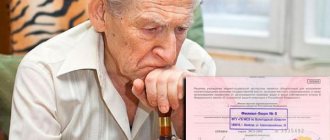The text is presented for informational purposes only. We strongly urge you not to self-medicate. When the first symptoms appear, consult a doctor. We recommend reading: “Why you can’t self-medicate?”
Parkinson's disease is a neurological pathology with slow progression, which most often occurs in older people. Parkinson's disease is also referred to in medical literature as idiopathic parkinsonism syndrome, or “shaking palsy.” This is a degenerative disease of the extrapyramidal motor system, caused by the death of brain neurons that produce the neurotransmitter dopamine, which leads to increased influence of the basal ganglia on the cerebral cortex.
Classification of the disease
Parkinson's disease is a pathology that doctors can identify in patients all over the world. The disease can be classified according to many criteria - the age when the first signs of the disease began to appear, manifestations, stages of progression, etc. Knowledge of the basics of the classification of parkinsonism helps to develop the correct treatment tactics for the disease in the early stages.
By age of onset of illness
Many older people suffer from Parkinson's disease; after 65 years, 1% of the entire population of the planet hears this diagnosis, and after 85 – more than 2.5% of people. On average, the disease begins in patients after 55 years of age, but there are cases of parkinsonism with an early onset - in 10% of all cases known to science, the disease occurred before the age of 40 years, or even before the age of 20 years, which indicates juvenile parkinsonism.
Juvenile parkinsonism should be understood as early genetically determined parkinsonism that occurs before the age of 20-25 years. The clinical manifestations of this pathology include symmetrical static and kinetic tremors, dyskinesia, pyramidal signs, and intellectual impairment. Juvenile pathology is a hereditary disease of the central nervous system, which is transmitted genetically through autosomal recessive mechanisms. The hereditary nature is the main difference between juvenile pathology and standard Parkinson's disease, which is caused by a multifactorial etiology. After the discovery of the Parkin gene in 1998, the introduction of DNA diagnostic techniques for defects in this gene into medicine allowed specialists to identify cases of juvenile parkinsonism much more often. The prevalence of this pathology has no territorial restrictions, in terms of gender - it is more common in women.
Early-onset parkinsonism is a disease that occurs in people under 45 years of age and is most often caused by genetic factors. An association of Parkinson's disease with certain gene polymorphisms in the detoxification of xenobiotics, in the antioxidant cellular defense system, in dopamine metabolism, and in the process of lipid metabolism has been established. When carriers of allelic genes are detected, the risk of developing Parkinson's disease in the body increases, and a hereditary predisposition to the pathology arises. The combination of unfavorable polymorphisms provokes early manifestation of the disease. It is important to understand that it is at a young age that the causes of Parkinson’s disease most often become genetic predispositions, while in the elderly this pathology is more often provoked by environmental and other factors.
A pathology with a late onset is considered to be Parkinson's disease, which occurs after 85 years, without previously showing any signs.
According to the manifestations of the disease
Depending on the manifestations and symptoms of the disease, the pathology in question can be divided into:
- trembling form, which is very characterized by tremor of the head, limbs, lower jaw with high or medium amplitude, as well as increased (sometimes normal) muscle tissue tone;
- trembling-rigid form, in which tremor occurs in the distal parts of the limbs and, as the disease progresses, stiffness during voluntary movements is added;
- akinetic-rigid form (the most unfavorable of all), in which the patient’s activity of movement drops sharply, often reaching the point of immobility, and muscle tone sharply increases, which threatens the occurrence of muscle contracture;
- a mixed form, in which all of the above forms can appear both together and flow into one another;
- an atypical form, which is characterized by synucleinopathy (dementia with Lewy bodies, idiopathic parkinsonism, etc.) or tauopathy (corticobasal dementia, supranuclear gaze paresis, etc.).
Each form of Parkinson's disease, in addition to differences in manifestations, may require specific therapy and patient care.
Epidemiology
According to a continuous population study, the prevalence of PD in Russia is 139 cases per 100,000 population, the incidence of PD is 16 cases per 100,000 population per year. With increasing age, the risk of PD increases, and the detection rate of PD among people over 65 years of age is already about 1%. Most cases of the disease occur between the ages of 60 and 70 years. However, in 15% of cases, PD debuts before the age of 45 years.
Based on the available data and the age-sex structure of the Russian population, we can roughly estimate the total number of patients with PD in our country at 210 thousand, with the disease occurring in approximately 20 thousand patients each year. Approximate calculations show that at least a quarter of patients (that is, more than 50 thousand) end up outside the scope of medical care, and most of these are patients with an early stage of the disease [3].
Causes and mechanism of development
The causes of Parkinson's disease do not always provoke the disease directly; more often, under their influence, the syndrome of parkinsonism is formed, which responds well to treatment, in contrast to the main form of the disease. Among the main causes of Parkinson's disease are:
- damage by high doses of free radicals of the black substance;
- highly toxic damage to the meninges, which can occur during periods of poisoning, with internal intoxication due to the release of toxins from the liver;
- heredity, which manifests itself in approximately 20% of cases of all diagnosed pathologies of this kind and has an indirect effect on the occurrence of the disease;
- genetic factor, in which the presence of modified genes in the genetic code provokes parkinsonism at a young age;
- lack of vitamin D, which is responsible for building protective barriers that prevent free radicals and toxic substances from entering the body, the deficiency of which becomes especially noticeable in old age;
- inflammations caused by bacterial or viral infection, such as encephalitis and others;
- brain injuries of varying degrees of severity;
- high cholesterol, which provokes atherosclerotic changes;
- degenerative brain processes due to impaired blood circulation.
All of the above factors can shape the etiology of the disease, but they are not stable in this matter and do not always provoke such processes.
The mechanism of development of the disease at the initial stage is characterized by a decrease in the production of dopamine, which provokes changes in the brain. Degeneratively changed areas of the brain begin to die, which leads to the characteristic symptoms of the disease. When the disease begins at a young age, it is worth understanding that the processes are caused by hereditary factors, and with a late onset of the disease, in the vast majority of cases, it is worth keeping in mind the mechanism of development of the pathology due to various external influences on the patient’s body.
Despite the fact that the obvious causes of Parkinson's disease have not yet been identified, the ways of diagnosing and treating the pathology have long been known, they are determined in each specific case individually and often help to maintain the patient's condition at the proper level.
Main manifestations
The main manifestations of Parkinson's disease are considered to be tremor, hypokinesia, muscle rigidity and postural instability, as well as mental and autonomic disorders.
Tremor or shaking is the most obvious and pronounced symptom of the disease, which most often bothers a person at rest, but can also occur as a postural or intentional manifestation. The frequency of tremor in parkinsonism reaches 4-6 movements per second. The tremor usually begins from the distal part of either arm, and as it progresses, it spreads to the second arm and both legs. The movement of the patient's fingers with tremor may superficially resemble counting coins. Head tremors may also occur, manifested by “yes-yes” or “no-no” movements, trembling of the eyelids, jaw or tongue. Very rarely, tremor in parkinsonism covers the entire body. Most often, it intensifies in stressful situations; it can usually be noticed in the patient at rest, and when moving, the trembling subsides or disappears completely.
Hypokinesia is understood as a decrease in the level of spontaneous activity of movements, which results in many hours of immobility of the patient.
There is stiffness in the human body; he can move actively only after some delay, and then at a slow pace (characterizes the resulting bradykinesia). A person’s steps become small, the gait is like a doll’s, and the feet are positioned clearly parallel to each other. At the same time, the patient’s facial expression and gaze are frozen, there is pronounced facial expression, a smile, and a crying grimace appears on the face very slowly, inhibited.
A person often freezes in a mannequin pose. His speech is monotonous and gradually fades away. Handwriting becomes choppy and small, which characterizes the development of micrography. Also, as a manifestation of hypokinesia, oligokinesia and synkinesia may occur, that is, a reduction in the total number of movements and the disappearance of friendly movements in the patient, such as sweeping arm movements when walking, wrinkling of the forehead when looking up, and so on. The patient can no longer perform parallel actions; all his movements become automatic.
Rigidity of muscle tissue is manifested by a uniform increase in muscle tone of the plastic plane. In this case, the limbs freeze in a bent position or in a fully extended state, which is a manifestation of plastic wax flexibility. If rigidity begins to predominate in some muscle groups, then a mannequin or supplicant pose arises, in which there is a stooped head, a tilt of the head forward, the arms are half-bent at the elbows and pressed against the body, and the legs are half-bent at the hip and knee joints. If you try to passively bend and straighten the wrist joints and forearms, you can feel a stepwise pattern of muscle tension or a “gear wheel” symptom.
When muscle tone changes, the limbs can no longer spontaneously return to their original position after any action performed. This characterizes the occurrence of the Westphal phenomenon, when, with a sharp dorsiflexion of the foot, it remains in this position for some time and does not straighten on its own.
In the later stages of the disease, postural instability occurs. The patient cannot spontaneously overcome either the inertia of rest or the inertia of movement; can hardly begin to move, and once it starts, it can no longer stop. When moving forward, the body begins to get ahead of the legs, the center of gravity in the body is disturbed, a loss of stability occurs and the person falls. This symptom may go away on its own after sleep or under the influence of other factors, but after some time it returns again.
In addition to impaired motor activity, patients with Parkinson's disease usually have pronounced mental and autonomic disorders and metabolic disorders. As a result, the patient may experience obesity, exhaustion, and increased secretory activity of the sebaceous, sweat and salivary glands.
Symptoms and signs in women
Clinicians note the following signs of pathology that occur at an early stage:
- Malaise, weakness.
- Changing handwriting.
- Muscle stiffness.
- Trembling of the hands and fingers (tremor).
- Changes in gait.
- Lack of facial expressions (“Parkinson’s mask”).
- Sleep disorder.
- Changes in speech (unintelligible, slow, slurred speech).
- Depression, frequent mood swings.
As the disease progresses, its main symptoms appear:
- Increased muscle rigidity (stiffness in movements and excessive muscle tension occurs).
- Visual deformation of the arms and legs (limbs are in a bent position).
- Continuous tremor of the hands.
- Fragmentary memory loss.
- Bradykinesia.
- Muscle spasms.
- Dementia.
- Defecation disorders.
- Disorientation in space.
- Long-term depression.
- Excessive sweating.
- Sleep pattern disorder.
Early diagnosis will help to significantly slow down the progression of the disease and improve the patient’s quality of life.
Progression of the disease and its severity
Parkinson's disease tends to progress, and the overall prognosis of the disease largely depends on the degree of such progression. The pathology can have a rapid rate of progression, when the stages of the disease replace each other over 2 years, a moderate type of progression, if the change of stages occurs over 5 years, and a slow rate, in which the change of stages of Parkinson's disease occurs no more than once every 5 years or less often.
The inevitability of the progression of pathology has necessitated a detailed study of its stages, each of which has its own symptoms and signs and requires specific therapy. The classification of the stages of parkinsonism was adopted in medicine back in 1967 and since then it has only been slightly adjusted. Today, the classification of the disease includes 6 main stages:
- Level zero Parkinson's disease has no obvious signs. Asymptomatic progression provokes its worsening due to lack of timely treatment. At the same time, many do not pay attention to such signs of the zero stage as forgetfulness, obsession and other signs that, in the understanding of an ordinary person, are not symptoms of the disease. However, if you pay due attention to them and start timely treatment, the progression of the disease can be stopped, preventing its development.
- In the first degree of the disease, unilateral damage to the body or limbs may occur in a mild form, due to which patients and their environment also rarely pay attention to these pathological changes and do not begin treatment.
- The second degree of parkinsonism is characterized by the gradual addition of pathological processes in the second half of the body or limbs. Again, the second degree occurs in a mild form, so rarely do any patients, even at this stage, pay attention to their own health and consult a doctor. In the second degree of parkinsonism, balance is completely preserved and there are no postural symptoms.
- When the disease moves to the third stage, patients may begin to complain of some restrictions when performing work or movements, but these restrictions do not affect everyday life in any way, therefore, in the vast majority of cases, this stage remains practically unnoticed and untreated.
- At the fourth stage of the disease, all the symptoms that previously appeared in a mild form sharply intensify, which leads to the patient losing independence in actions and movements. At the fourth stage of parkinsonism, people do not have problems with standing, but already have problems with movement.
- The fifth degree of Parkinson's disease is the most severe and difficult to treat, since a person without outside help becomes literally bedridden, he is completely unable to cope without outside support, his body ceases to obey him.
Diagnostics
The diagnosis of PD is carried out in 2 stages. At the first (syndromic) stage, parkinsonism syndrome must be distinguished from other conditions that mimic it (Table 1).
Table 1. Conditions requiring differential diagnosis with parkinsonism.
| If there is tremor | In the absence of tremor |
| Increased physiological tremor Essential tremor Dystonic tremor Hepatolenticular degeneration | Apathetic-abulic syndrome Depression Frontal dysbasia Humeral periarthropathy Hypothyroidism Cervical osteochondrosis Dementia with the phenomenon of paratonia (continuity) Catatonia |
Identifying signs of hypokinesia is key in differential diagnosis. Initial symptoms of hypokinesia may be characterized by difficulty writing, pressing buttons on a remote control, brushing teeth, typing on a keyboard, removing small objects such as coins from a bag or pocket, putting on slippers, etc. Sometimes, already at an early stage, weakness and lag of one of the legs when walking appears with a change in the usual gait pattern. Characterized by a weakening of friendly arm movements when walking (acheirokinesis), impaired recharging of the watch (“Rolex symptom”). A weakened voice, slowness, weakening of intonation, or unclear speech may be noticed (especially when pronouncing morphologically complex words quickly). When examined to identify hypokinesia, the patient is asked to perform certain movements for about 20 seconds at the fastest pace and with maximum amplitude. In this case, the doctor should pay attention to the slow initiation of movement, asymmetry of movements, but most importantly - to a special form of exhaustion of movements (decrement), which, as they are repeated, become increasingly slower, decrease in amplitude, and require more and more effort from the patient. The phenomenon of exhaustion can be detected in all movements assessed, but is sometimes noted only in one of the tests. It should be borne in mind that the slowness and awkwardness of movements characteristic of patients with parkinsonism at an early stage can be confused with manifestations of pyramidal and cerebellar insufficiency, as well as severe depression, however, these conditions are not characterized by a decrement of movements as they are repeated. It should be borne in mind that hypokinesia can be difficult to detect against the background of severe tremor in a limb, however, even in this case it is important not to miss a diagnostically significant phenomenon: with parkinsonism, after performing a test for hypokinesia, the patient often holds his hand in a fixed, tense position and is not able to quickly relax.
Muscle rigidity is manifested by stable (as opposed to spasticity) resistance to passive movements in the wrist, elbow, shoulder, knee joints, as well as in the neck, and subjectively by stiffness and unpleasant painful sensations in the limbs. In some patients, when checking their tone, the “gear wheel” phenomenon is revealed. Rigidity should be distinguished from the phenomenon of resistance (gegenhalten), characteristic of patients with dementia and damage to the frontal lobes. Counter-containment changes rapidly depending on the direction and speed of passive movement.
Slow (3–4 Hz) resting tremor in one arm or leg is one of the common initial manifestations of parkinsonism. The presence of a classic resting tremor of the “rolling pills” or “counting coins” type is most characteristic of PD. To identify latent tremor, the patient is asked to make movements with the other hand, walk around, and perform a distraction task (for example, subtracting from 100 by 7). To identify tremors in the leg, you need to examine the patient in a sitting or lying position. However, in the absence of hypokinesia, rest tremor does not allow diagnosing either parkinsonism or PD. It should be taken into account that, on the one hand, essential and dystonic tremor can be observed at rest, on the other hand, postural and kinetic tremor is often observed in PD.
The initial manifestation of PD, especially in young people, may be foot dystonia, which appears or worsens when walking, and much less often - dystonia of other localization.
Early non-motor disorders. Starting from the earliest (prodromal) stage of the disease, the patient may be bothered by emotional depression, increased irritability, fatigue or a feeling of constant fatigue, as well as autonomic disorders such as sweating disorders (“defective thermostat”), for example, profuse sweating in cold weather, and also a tendency to constipation, frequent and/or imperative urination, increased drooling at night (the “wet pillow” symptom), erectile dysfunction. Hypoosmia often occurs already in the premotor stage of PD, but rarely attracts the attention of the patient himself, and a formalized study is necessary to identify it (using special techniques, for example, the University of Pennsylvania Olfactory Test - UPSIT). Identifying signs of rapid eye movement sleep behavior disorder syndrome (anxious dreams, vocalizations, sleep-talking, movements reflecting the content of dreams), which may precede other manifestations of the disease for many years, may be of important diagnostic importance. These non-motor manifestations may improve the accuracy of diagnosis based on early motor symptoms of the disease.
The debut manifestations of PD are also chronic pain syndromes, most often in the back and scapulohumeral region, associated with increased muscle tone, limited mobility and postural disorders.
Already at an early stage, signs of mild cognitive impairment may be detected, in particular instability of attention and slowness of thinking, difficulty finding words (the “tip of the tongue” phenomenon).
"Red flags". The second stage - the stage of nosological diagnosis - comes down to the differential diagnosis of PD with other nosological forms of parkinsonism. It requires a clinical assessment of the history and neurological examination findings. It is important to clarify the drug history. Drugs such as metoclopramide, sodium valproate, cinnarizine, amiodarone can cause drug-induced parkinsonism. Discontinuation of the drug that triggered the development of parkinsonism may not lead to immediate regression of symptoms. Sometimes, after taking the drug and a short-term improvement, the condition worsens again, which indicates a latently developing degenerative process that was “unmasked” by the side effects of the drugs.
A neurological examination may reveal symptoms that are atypical for PD, requiring the exclusion of other diseases that cause parkinsonism. Among them are: symmetry, rapid progression of symptoms with early loss of the ability to move within 5 years, early development of postural instability with falls, lack of a persistent positive effect of adequate doses of levodopa, early development of autonomic failure, rapid onset of dementia (within 1- year), limited mobility of the eyeballs (especially paresis of downward gaze), early development of severe pseudobulbar syndromes, axial dystonia, pyramidal and cerebellar signs, the presence of focal disorders of cortical functions.
Diagnosis of the disease
Parkinson's disease is more common in older people and is irreversible, but diagnosis is necessary to maintain the patient's normal level of functioning and timely selection of appropriate treatment. Early diagnosis plays a key role in this aspect.
The diagnosis of Parkinson's disease is easily made even based on the external symptomatic manifestations of the disease. The difficulty is that other neurological pathologies may have similar symptoms, so doctors are in no hurry to make a diagnosis without examinations. The more complete the picture of the course of the disease, the more effective the therapy will be selected and the longer the patient will live, maintaining quality of life.
Nevertheless, the main method for diagnosing parkinsonism is the clinical picture of the disease. The specialist takes into account and considers all data indicating the occurrence of this pathology in a comprehensive manner. Topical diagnosis of Parkinson's disease is also often carried out, which is a complex diagnosis with the help of which the localization of a pathological focus in the patient's brain or a complex of such lesions is easily determined. The basis for topical diagnosis is often the clinical picture of the disease. In addition, there are other methods for diagnosing parkinsonism, among which differential diagnosis occupies an important place.
Differential diagnosis
The differential diagnosis of Parkinson's disease implies a very careful consideration of clinical data and their study. The fact is that if the patient’s history does not have pronounced symptoms of parkinsonism, then making a diagnosis can become a whole problem for the doctor.
It is very important to differentiate the symptoms observed in the patient from the symptoms of prolonged depression, post-stroke condition and other pathological conditions.
It is important to understand that in medicine today there are no special tests that can be used to determine Parkinson’s disease. The importance of differential diagnosis is determined by the fact that it must be carried out regularly between courses of treatment in order to understand their effectiveness and promptly make competent adjustments to them.
Diagnosis of disease using MRI
To confirm the diagnosis of parkinsonism at any stage of the disease, an MRI of the patient’s brain can be performed, since the death of nerve cells during degenerative changes is reflected by changes in visualization in the form of characteristic radiological signs.
In addition, MRI does not use X-rays, which can have a negative effect; this examination is non-invasive, since no human tissues or structures are damaged during the process. Magnetic resonance imaging is performed completely painlessly for people. To make the MRI result more informative, sometimes special contrast agents are used during diagnosis, which are introduced into the body through intravenous injections. Contrast enhances the information content of an MRI and, based on such data, a diagnosis can be made more accurately and effective treatment can be prescribed.
Additional research methods
At the moment, there are no laboratory or instrumental research methods that would be mandatory for every patient with suspected PD. In recent years, patients with PD have often undergone CT or MRI of the brain, but most often this is not necessary, and in most cases the diagnosis can be made based on clinical findings. However, if the clinical picture in a patient with parkinsonism syndrome deviates from the classic variant characteristic of PD, in particular, there is no typical response to dopaminergic drugs, then neuroimaging is necessary.
When the onset of the disease is before 50 years of age, it is important to exclude hepatolenticular degeneration, which may be indicated by a corneal Kayser-Fleischer ring, low ceruloplasmin levels, increased signal intensity from the basal ganglia and cerebellum on T2-weighted MRI images, and increased urinary copper excretion.
Transcranial sonography of the deep structures of the brain may also have diagnostic significance, revealing in PD hyperechoic changes in the projection of the substantia nigra, associated with the accumulation of iron and established in 92% of cases of clinically probable PD, but its results can only be interpreted in a clinical context.
Of the practically important, but not yet available in our country, diagnostic methods include positron emission tomography (PET) and single-photon emission computed tomography (SPECT), which make it possible to study synaptic transmission at all levels, as well as monitor the pathological process. When detecting a decrease in the accumulation of F18-fluorodopa with PET and β-CIT with SPECT in the striatum, we can talk about the involvement of presynaptic nigrostriatal terminals in the pathological process (primary parkinsonism). Determination of decreased accumulation of 11C-raclopride (D2 receptor ligand) in PET will indicate a decrease in the number of dopamine receptors in the striatum (parkinsonism “plus”).
Principles of treatment
For effective treatment of Parkinson's disease, it is necessary to diagnose the disease in a timely manner and prescribe appropriate therapy. Complex treatment of this pathology involves a whole range of measures:
- the use of drug therapy, which, in addition to symptomatic medications, must necessarily include the use of neuroprotectors;
- rehabilitation procedures, including medical and social means;
- neurosurgical methods of intervention.
Modern medicine in the treatment of Parkinson's disease adheres to two main principles - to prevent the development of the disease by stopping the process of degeneration of brain tissue and to eliminate the symptoms of the disease so that the patient begins to feel much better. Both of these goals must be achieved taking into account the degree of progression of the disease in the patient.
Medicines that have not been proven to be effective in PD
In clinical practice, medications are widely used whose effectiveness in PD has not been proven and which, therefore, cannot be recommended for use in this disease. First of all, these include the so-called nootropic, neurometabolic and vasoactive drugs. It is possible that some of these drugs have some therapeutic effect, but before recommending a specific drug, an adequate assessment of its effectiveness should be carried out. Specialists involved in the treatment of PD are well aware that a certain proportion of patients respond well to placebo, and this effect is not durable. Accordingly, the costs of such treatment turn out to be meaningless.
Literature
- Golubev V.L., Levin Ya.I., Vein A.M. Parkinson's disease and parkinsonism syndrome. M.: MEDpress-inform, 1999.
- Levin O.S., Fedorova N.V., Smolentseva I.G. Dopamine receptor agonists in the treatment of Parkinson's disease. Rus. honey. magazine 2000; 15–16: 643–646.
- Levin O.S., Fedorova N.V. Parkinson's disease. M.: MEDpress-inform, 2011.
- Patient management protocol. Parkinson's disease. Problem standardization in healthcare. 2005; 3: 74–166.
- Chwieduk CM, Curran MP Pramipexole extended release in Parkinson's disease. CNS Drugs 2010; 24: 327–336.
- Grosset KA, Bone, Grosset DG Suboptimal medication adherence in Parkinson's disease. Mov. Discord. 2005; 20: 1502–1507.
- Hauser R., Salin L., Koester J. Double-blind evaluation of pramipexole extended-release (ER) in early Parkinson's disease. Neurology 2009; 72(11 Suppl. 3):A412–413.
- Kvernmo T., Härtter S., Bürger E. A review of the receptor-binding and pharmacokinetic properties of dopamine agonists. Clin. Therap. 2006; 28:1065–1078.
- Mizuno Y., Yamamoto M., Kuno S. et al. Efficacy of Pramipexole Extended Release (ER) and switching from Pramipexole Immediate Release (IR) to ER in Japanese advanced Parkinson's disease (PD) patients. In: XVIII WFN World Congress on Parkinson's Disease and Related Disorders: Miami Beach, 2009: Poster 2.192.
- Möller JC, Oertel WH Pramipexole in the treatment of Parkinson's disease: new developments. Expert Rev. Neurother. 2005; 5:581–586.
- Poewe W., Rascol O., Barone P. et al. Pramipexole extended-release in early Parkinson's disease. Neurology 2011; 77:759–766.
How to avoid pathology
The mechanism for the development of the disease is the process of death of brain cells in those parts of the brain where dopamine is produced. Most often, according to experts, the process is caused by age-related changes, and the occurrence of pathology due to other diseases is detected quite rarely. This suggests that at any age it is necessary to monitor your body, maintaining all its functions in working order. These actions will act as a prevention of parkinsonism.
The most important aspect of disease prevention is proper human nutrition.
With the help of food, you can maintain normal health of the cardiovascular system, prevent atherosclerotic changes, and fully nourish the brain cells in which dopamine and other substances essential for the functioning of the body are produced.
The text is for informational purposes only. We strongly urge you not to use diets, resort to any therapeutic menus or fasting without medical supervision. We recommend reading: “Why you can’t go on a diet on your own.”
A diet to prevent Parkinson's disease includes the following aspects:
- it is necessary to constantly consume a lot of fresh vegetables, herbs and fruits, bran, whole grains, which accelerate the process of peristalsis and prevent constipation;
- when using the drug Levodopa, you should not eat a lot of protein foods, since proteins reduce the effectiveness of such treatment;
- You should monitor your own weight, for which it is necessary to exclude simple carbohydrates and excess fat from food, if possible.
If you eat according to these principles, you can not only prevent the development of the disease, but also preserve the beauty and youth of all body systems for a long time, and enhance performance at any age.
In order to prevent parkinsonism, doctors recommend not to forget about physical activity. It is important to frequently be in the fresh air, lead an active lifestyle, do gymnastics or engage in any sport to improve oxygen supply to all tissues. At the same time, the blood circulation process is stabilized and the performance of brain structures improves.
Throughout your life, and especially at retirement age, it is important to regularly and continuously load your brain with work. And if in youth people often work, and there is no need for additional brain training, then after retirement many stop paying attention to this, but in vain. It is important to solve crosswords, learn something new, and create something with your own hands.
Preventive procedures regarding the occurrence of parkinsonism must necessarily include measures that strengthen the immune system. With a weakened immune system, many viral diseases weaken the body, and after this all sorts of complications often arise, as a result of which the meninges can be affected. This process can often be irreversible, so stimulation of the immune system should also be given sufficient attention.
Recommendations for patients
Nutrition rules
If you are diagnosed with Parkinson's disease, you should eat right. The diet should largely correspond to the one that was named as the prevention of the disease. First of all, you should not eat foods that cause constipation. It is better to enrich your diet with fiber, which helps improve the functioning of the digestive system. It is also very important to maintain a drinking regime and consume enough fluids for the full viability of the whole organism.
Blood thickening due to lack of fluid provokes thrombus formation, which, in turn, leads to disruption of the normal functioning of the vascular system and, as a consequence, in some cases, to the death of brain cells.
The menu for Parkinson's disease should be varied, products should contain a full range of vitamins and minerals. Alcohol and tobacco are strictly contraindicated, especially in case of parkinsonism in old age with a history of concomitant pathologies.
Other contraindications
Among the main contraindications for Parkinson's disease is the use of medications without a doctor's prescription. For this pathology, before prescribing medications, the specialist must conduct a comprehensive examination of the patient’s body, identify associated problems and prescribe medications, the use of which will not contribute to the intensification or occurrence of other diseases. Certain antiparkinsonian medications are used to treat Parkinson's disease. These include dopamine activators, which inhibit the process of brain cell death. However, it must be remembered that some other medications can block the production of dopamine or inhibit the activity of the brain receptors responsible for its functioning in the body.
Among these drugs, experts identify:
- vasoactive drugs (cinnarizine);
- neuroleptics (torecan, haloperidol);
- antihypertensive drugs (adelfan).
In addition to not taking the above-mentioned remedies, you should remember that taking any treatment, even non-drug (folk) treatment, must be agreed with your doctor. It is also strictly forbidden to cancel medications prescribed by a specialist without permission.
Any intervention in the treatment regimen for Parkinson's disease is a contraindication. All patients should remember that they should not perform physical exercises that require sudden movements, or perform gymnastics where physical inactivity will prevail. Any physical activity for parkinsonism should prevent the process of tissue atrophy in the patient’s body.
General principles for starting treatment
Since at the moment the ability to slow down the process of degeneration due to the neuroprotective effect (the ability to protect intact cells from damage) or the neuroreparative effect (the ability to restore the activity of partially damaged cells) has not been convincingly proven in any of the drugs used, treatment is still based on symptomatic action. However, the potential for a neuroprotective effect, supported by experimental or clinical data, should be taken into account when prescribing treatment.
Currently, a widely accepted concept emphasizes the importance of early administration of dopaminergic therapy - immediately after diagnosis - in order to more quickly correct neurochemical imbalances in the brain and support compensation processes.
If previously the need for maintaining monotherapy as long as possible was emphasized, at present the advantages of this approach do not seem obvious - compared with an early transition to a combination of drugs with different mechanisms of action. The need for monotherapy or combination therapy should be decided individually. In any case, when choosing drugs and their dosage, one should strive not for complete elimination of symptoms, but for a significant improvement in function, allowing one to maintain everyday and professional activity. At the same time, you should avoid making several changes to the treatment regimen at once (for example, increasing the dose of several drugs at once or adding several drugs at once), this allows you to separately evaluate the effectiveness and safety of each of the prescribed drugs.
Complications and consequences
As a result of Parkinson's disease, the patient may face a whole range of consequences. All of them are provoked directly by the disease and lead to various pathologies or to the progression of parkinsonism itself.
The presence of tremor in patients changes the appearance of patients and their behavioral reactions. With muscle disorders, a person loses a significant amount of facial expressions, his appearance takes on the features of indifference. Stiffness and rigidity of muscle tissue contribute to awkward postures of a person, in which he is comfortable, but which look rather strange. Disturbances in the functioning of the nervous system provoke the occurrence of seizures, insomnia, constipation, hallucinations and even dementia.
The consequences of Parkinson's disease are largely determined by the stage of its progression. Some forms of the disease are not so dangerous, others often lead to the rapid development of pathology.
With competent support for the patient, it is possible to ensure his life with a minimum of changes due to the disease. People do not die from Parkinson's disease; deaths are caused by complications of the disease. Even a simple cold in the last stage of parkinsonism can lead to bronchitis and pneumonia, from which a person can die.
How long do patients live?
Parkinson's disease itself does not cause death to the patient, but it greatly impairs the quality of life and can lead to disability. Among the main causes of death in patients with parkinsonism are processes such as:
- pneumonia;
- dysphagia or suffocation;
- infectious diseases with complications;
- cardiovascular pathologies;
- injuries;
- somatic changes;
- neuroleptic syndrome due to constant use of Levodopa.
Best materials of the month
- Coronaviruses: SARS-CoV-2 (COVID-19)
- Antibiotics for the prevention and treatment of COVID-19: how effective are they?
- The most common "office" diseases
- Does vodka kill coronavirus?
- How to stay alive on our roads?
At the same time, regarding Levodopa, it is worth noting that in general, the life expectancy of patients who use such treatment is several times higher than that observed in persons without such therapy.
The basis for predicting life expectancy when parkinsonism is detected is the degree of progress and stage of the patient’s disease, as well as the age at which the disease made itself felt. Symptoms of the disease can increase over many years, gradually leading to disability. However, everything is individual and is largely determined by the effectiveness and timeliness of the treatment started. Many patients with Parkinson's disease live more than 20 years, and death occurs not from the disease or its complications, but due to the natural aging of the body.
The prognosis regarding the issue of complete recovery is unfavorable, since today Parkinson's disease cannot be completely eliminated. All therapy for this pathology is not aimed at overcoming it, but at delaying the progress of the clinical picture and inhibiting the process of death of neurons in the patient’s brain.







